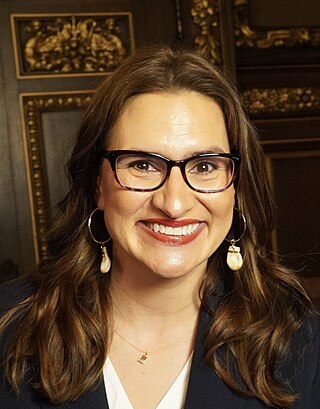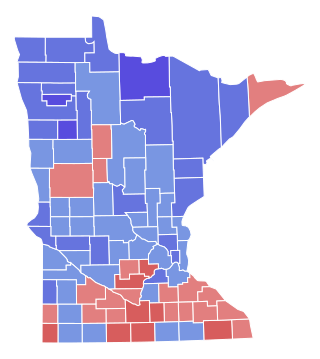
The Minnesota House of Representatives is the lower house of the U.S. state of Minnesota's legislature. It operates in conjunction with the Minnesota Senate, the state's upper house, to craft and pass legislation, which is then subject to approval by the governor of Minnesota.

The lieutenant governor of Minnesota is a constitutional officer in the executive branch of the U.S. state of Minnesota. Fifty individuals have held the office of lieutenant governor since statehood. The incumbent is Peggy Flanagan, a DFLer and the first Native American elected to a statewide executive office in Minnesota's history.

Minnesota is known for a politically active citizenry, with populism being a longstanding force among the state's political parties. Minnesota has consistently high voter turnout; in the 2008 U.S. presidential election, 77.8% of eligible Minnesotans voted – the highest percentage of any U.S. state or territory – versus the national average of 61.7%. This was due in part to its same day voter registration laws; previously unregistered voters can register on election day, at their polls, with evidence of residency.
The following table indicates the party of elected officials in the U.S. state of Minnesota:

The 1956 United States presidential election in Minnesota took place on November 6, 1956, as part of the 1956 United States presidential election. Voters chose 11 electors, or representatives to the Electoral College, who voted for president and vice president.

The 1970 Minnesota lieutenant gubernatorial election took place on November 3, 1970. State Senator Rudy Perpich of the Minnesota Democratic-Farmer-Labor Party defeated Duluth Mayor Ben Boo of the Republican Party of Minnesota. The 1970 lieutenant gubernatorial election was the final lieutenant gubernatorial election held before the Minnesota Constitution was amended to provide for elections of the Governor and Lieutenant Governor on a joint ticket.

The 1960 Minnesota lieutenant gubernatorial election took place on November 8, 1960. Incumbent Lieutenant Governor Karl Rolvaag of the Minnesota Democratic-Farmer-Labor Party defeated Republican Party of Minnesota challenger Art Ogle.

The 1958 Minnesota lieutenant gubernatorial election took place on November 4, 1958. Incumbent Lieutenant Governor Karl Rolvaag of the Minnesota Democratic-Farmer-Labor Party defeated Republican Party of Minnesota challenger Bernard E. Ericsson.

The 1948 Minnesota lieutenant gubernatorial election took place on November 2, 1948. Incumbent Lieutenant Governor C. Elmer Anderson of the Republican Party of Minnesota defeated Minnesota Democratic-Farmer-Labor Party challenger John T. McDonough.

The 1946 Minnesota lieutenant gubernatorial election took place on November 5, 1946. Incumbent Lieutenant Governor C. Elmer Anderson of the Republican Party of Minnesota defeated Minnesota Democratic-Farmer-Labor Party challenger Frank McGinn.

The 1940 Minnesota lieutenant gubernatorial election took place on November 5, 1940. Incumbent Lieutenant Governor C. Elmer Anderson of the Republican Party of Minnesota defeated Minnesota Farmer–Labor Party challenger Howard Y. Williams and Minnesota Democratic Party candidate Frank Patrick Ryan.

The 1928 Minnesota lieutenant gubernatorial election took place on November 6, 1928. Incumbent Lieutenant Governor William I. Nolan of the Republican Party of Minnesota defeated Minnesota Farmer–Labor Party challenger Thomas J. Meighen and Minnesota Democratic Party candidate Fred Pfaender.

The 1926 Minnesota lieutenant gubernatorial election took place on November 2, 1926. Incumbent Lieutenant Governor William I. Nolan of the Republican Party of Minnesota defeated Minnesota Farmer–Labor Party challenger Emil E. Holmes and Minnesota Democratic Party candidate Charles D. Johnson.

The 1922 Minnesota lieutenant gubernatorial election took place on November 7, 1922. Incumbent Lieutenant Governor Louis L. Collins of the Republican Party of Minnesota defeated Minnesota Farmer–Labor Party challenger Arthur A. Siegler and Minnesota Democratic Party candidate Silas M. Bryan.

The 1920 Minnesota lieutenant gubernatorial election took place on November 2, 1920. Republican Party of Minnesota candidate Louis L. Collins defeated Independent challenger George H. Mallon and Minnesota Democratic Party candidate James P. McDonnell.

The 1918 Minnesota lieutenant gubernatorial election took place on November 5, 1918. Incumbent Lieutenant Governor Thomas Frankson of the Republican Party of Minnesota defeated Minnesota Democratic Party challenger Charles H. Helweg and National Party candidate George D. Haggard.

The 1916 Minnesota lieutenant gubernatorial election took place on November 7, 1916. Republican Party of Minnesota candidate Thomas Frankson defeated Minnesota Democratic Party challenger Julius Thorson, Socialist Party of Minnesota candidate Andrew Hanson, and Prohibition Party candidate L. A. Simonson.

The 1914 Minnesota lieutenant gubernatorial election took place on November 3, 1914. Incumbent Lieutenant Governor J. A. A. Burnquist of the Republican Party of Minnesota defeated Minnesota Democratic Party challenger Charles M. Andrist, Socialist Party of Minnesota candidate Andrew Hanson, and Prohibition Party candidate A. W. Piper.

The 1908 Minnesota lieutenant gubernatorial election took place on November 3, 1908. Incumbent Lieutenant Governor Adolph Olson Eberhart of the Republican Party of Minnesota defeated Minnesota Democratic Party challenger Julius J. Reiter and Prohibition Party candidate T. J. Anderson.

The 1904 Minnesota lieutenant gubernatorial election took place on November 8, 1904. Incumbent Lieutenant Governor Ray W. Jones of the Republican Party of Minnesota defeated Minnesota Democratic Party challenger Fendall G. Winston.
This page is based on this
Wikipedia article Text is available under the
CC BY-SA 4.0 license; additional terms may apply.
Images, videos and audio are available under their respective licenses.
















